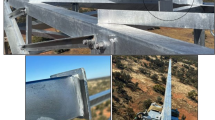Abstract
Corrosion resistances of mild steel specimens according to artificial neural network (ANN) analysis were investigated in the scope of this study. Corrosion rate values were taken into numerical analysis as a result of experimental studies under corrosive aggressive media. Mild steel specimens were selected according to the section type varieties such as box, tube and cornier. All steel specimens were subjected to the aggressive media formed using sodium chloride (NaCl with 99.8 % purity) solutions with 3.5, 5.0 and 7.0 % ratios per one liter distilled water and only distilled water. The reduction in corrosion rate has been observed and considered according to some corrosion loss respects. Corrosion rate prediction models were established between corrosion rate and parameters such as mass loss obtained by experimental studies using ANN. ANNs are computing systems that simulate the biological neural systems of the human brain. In this study, ANN analysis was generated to predict the corrosion rate values after experimental studies. Experimental and predicted values were compared by each other and it is seen that a strong relationship was established between them.



Similar content being viewed by others
References
Guthrie J, Battat B, Grethlein C (2010) Accelerated corrosion testing, Jeffrey Guthrie. The AMPTIAC Quarterly 6(3):11–15
Melchers RE, Chernov BB (2010) Corrosion loss of mild steel in high temperature hard freshwater. Corros Sci 52:449–454
Han L, Song S (2008) A measurement system based on electrochemical frequency modulation technique for monitoring the early corrosion of mild steel in seawater. Corros Sci 50(6):1551–1557
Melchers RE (2006) Modelling immersion corrosion of structural steels in natural fresh and brackish waters. Corros Sci 48(12):4174–4201
Xue J, Michelle S, Fatt H (2001) Buckle propagation in pipelines with non-uniform thickness. Ocean Eng 28:1383–1392
Melchers RE (1999) Corrosion uncertainty modeling for steel structures. J Constr Steel Res 52:3–19
Jones DA (1996) Principles and prevention of corrosion. Prentice-Hall, New Jersey
Möller H, Boshoff ET, Froneman H (2006) The corrosion behaviour of a low carbon steel in natural and synthetic seawaters. J S Afr I Min Metall 106:585–592
Siddique R, Aggarwal P, Aggarwal Y (2011) Prediction of compressive strength of self-compacting concrete containing bottom ash using artificial neural networks. Adv Softw Eng 42:780–786
Guang NH, Zong WJ (2000) Prediction of compressive strength of concrete by neural networks. Cem Concr Res 30:1245–1250
Adeli H (2001) Neural networks in civil engineering: 1989–2000. Comput-Aided Civ Infrastruct Eng 16:126–142
Garson GD (1991) Interpreting neural-network connection weights. AI Expert 6:47–51
Werbos PJ (1994) The roots of back propagation: from ordered derivatives to neural networks and political forecasting. Wiley, New York
Rafiq MY, Bugmann G, Easterbrook DJ (2001) Neural network design for engineering applications. Comput Struct 79:1541–1552
Schumacher M (1999) Seawater corrosion handbook. Noyes Data Corporation, New Jersey
Qwen DM (2003) Report on the NACE TM0169 “Laboratory corrosion testing of Metals for the process industry” (ASTM G-31) Testsfor 1018 Carbon steel and 7075T6 non-cladaluminium exposed to diversified DVS 6000 scavenger. Diversified Industries
Author information
Authors and Affiliations
Corresponding author
Rights and permissions
About this article
Cite this article
Erdem, R.T., Seker, S., Ozturk, A.U. et al. Numerical analysis on corrosion resistance of mild steel structures. Engineering with Computers 29, 529–533 (2013). https://doi.org/10.1007/s00366-012-0279-5
Received:
Accepted:
Published:
Issue Date:
DOI: https://doi.org/10.1007/s00366-012-0279-5




